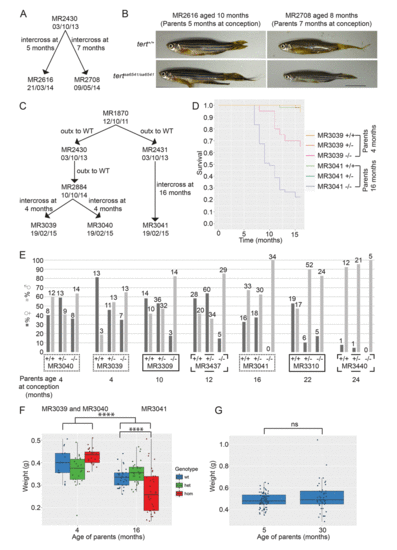- Title
-
The age of heterozygous telomerase mutant parents influences the adult phenotype of their offspring irrespective of genotype in zebrafish.
- Authors
- Scahill, C.M., Digby, Z., Sealy, I.M., White, R.J., Collins, J.E., Busch-Nentwich, E.M.
- Source
- Full text @ Wellcome Open Res
|
tertsa6541/sa6541 fish age prematurely. (A) Protein domain structure of zebrafish Tert. Depicted in yellow is the telomerase ribonucleoprotein complex RNA-binding domain (RBD), and in purple the reverse transcriptase domain (RTD). The position of three known alleles are shown. (B) tertsa6541/sa6541 fish age prematurely. Homozygous fish display a wasting phenotype. Scale bar: 10mm. (C) tertsa6541/sa6541 fish die prematurely compared to their siblings (n=92 homozygotes, n=92 heterozygotes, n=92 wild-types). (D) Photograph of capillaries containing sperm from wild-type sibling males (left) and clear fluid containing no sperm from tertsa6541/sa6541 males (right). (E) Homozygous tertsa6541 fish become prematurely infertile. All wild-type males but only 5.9% of homozygous males tested, aged 9 or 10 months, produced sperm. (F) Maternal-zygotic mutant embryos derived from tertsa6541/sa6541 intercrosses display a range of phenotypes by 24 h.p.f. including a reduction in head tissue and a shorter tail |
|
The age of heterozygous tertsa6541/+ parents affects the phenotype of their offspring. (A) Family tree depicting relationship between lines shown in (B). Lines numbers are indicated according to our fish stock database with date of birth underneath. (B) Homozygous fish from older heterozygous parents show signs of body wasting at a younger age than those from younger heterozygous parents. 8 month old fish from 7 month old heterozygous parents appear older than 10 month old fish from 5 month old heterozygous parents. Scale bar: 10mm. (C) Family tree depicting relationship of lines shown in (D) and (F). (D) Homozygous fish from 16 month old heterozygous parents have reduced survival compared to homozygotes from 4 month old heterozygous parents which were raised at the same time. (E) Sex ratios of intercrosses from tertsa6541/+ parents of different ages. Patterned boxes around line numbers indicate which lines were raised simultaneously in the nursery. Absolute numbers are indicated above each bar. (F) Box plot with scatter of weights of male fish from 4 or 16 month old heterozygous parents showing that fish from older parents weigh less than those from younger parents. (G) Box plot with scatter showing no significant difference between the weights of wild-type fish from wild-type parents aged 5 or 30 months. |
|
tertsa6541/sa25076 compound heterozygous fish display the same phenotype as tertsa6541/sa6541 homozygous fish. (A) Embryos produced from intercrosses of compound heterozygous fish display a range of phenotypes similar to those resulting from tertsa6541/sa6541 homozygous incrosses. (B) Compound heterozygous intercrosses produce clutches with fewer non-phenotypic embryos at 5 d.p.f. than wild-type sibling intercrosses. |



